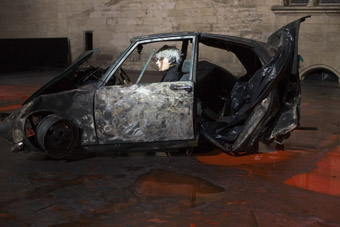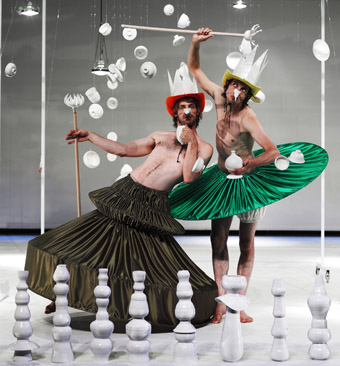 |
‘Andy Warhol’, Inferno, Romeo Castellucci, photo Luca Del Pia |
Romeo Castellucci’s Inferno is an ever-evolving cycle of striking images from an (after)life that is familiar, yet distant. White noise thunders painfully as we see our reflection in the mirrored wall of a giant cube. Suddenly the surface flicks into a transparent panel, beyond which a group of toddlers play with colourful toys, oblivious to the black silk cloud that ominously expands above them. Their amplified giggling pierces the auditorium. Next to the cube, a sinister Andy Warhol lifts his Polaroid camera and snaps us, the flash imprinting itself onto our retinas. Later, a crowd of many people gather around the now black-surfaced cube as haunting choral music intones oppressively. One by one, they climb onto the cube-top and, arms outstretched, drop backwards into white light, a stunning, angelic freefall of anonymous departure. As each of them plummets, the title of one of Warhol’s works appears on a screen above them.
Life is hell, art in its ephemerality is death, and this is the story of everyman, everywoman, everyone, of past and present and future. Like the recurring image of a circle that links the trilogy, it is now and forever. Inferno moves through the motions of a detached self-reflexive aesthetic, never drawing us close enough to feel the heat of its magnitude. Flames envelop a grand piano as the crowd stands by and stares, but I am left cold amongst eternal possibilities of meaning.
Following on from the harrowingly beautiful Purgatorio (RT 87, p4), Paradiso is an installation in which, five at a time, we clamber from a small white space through the circle of a dark tunnel into an endless, sightless, humid black. The sound of running water embraces us. Our eyes adjust to see arcs of a waterfall gushing from a gap high in the wall. And then something wriggling there, pale and small. An insect? An angel? Caught at its waist it squirms, panting and yelping, an embodiment of solitary helplessness.
Just as we can’t save the toddlers from the ‘dangerous’ cloud, we can do nothing to free this figure from its hostile eternity, yet we are imaginatively active in placing it there. We are continuously reminded of the necessity of our presence, but also of our powerlessness within this structure. Yet we struggle on.
 |
The Porcelain Project, Needcompany photo Miel Verhasselt |
More characters enter this absurd court to cavort around, kings and princesses in luxuriously coloured crinolines and hose, with oversized crowns and grotesquely phallic porcelain appendages. Their balletic elegance sweeps through into overtly sexual gestures, and the decadence of the porcelain seems to fall in on itself amid a strange exoticism, like some sort of disquieting colonial madness. The king orates nonsensically into a microphone, men grapple beneath women’s skirts and everyone is objectified by their porcelain appendages. The dancers continually look to us for approval with a childlike innocence that jolts when juxtaposed with the trembling, unsated eroticism of their dance. Drawn into this chaos, we’re never released from tension, abundance colouring this smooth, white, fantastical world. So what have we been responsible for creating?
Made during the Bush era, Rajni Shah’s durational performance, Dinner with America, is loaded with many images through which we must find our own path. The expansive floor is divided by a bark-chip maze that is gradually rearranged by two handmaidens, forcing us to relocate to new territory out of their way. Shah wears long gloves, a blonde wig and a white dress that stretches out across the floor around her. Her face is waxy white, both ‘beautiful’ and rigidly artificial. She slowly sings “Amazing Grace”, summoning echoes of the Trail of Tears, the Civil War, the evangelical South. She strikes potent gestures—a hand on the hip or a fist in the air—evoking multiple icons, from the Statue of Liberty to Marilyn Monroe. She continues to sing, glamorous, bored, defiant, sexy, poised, hollow, immaculate, and we watch on in solitary worship of this figure that morphs before and within us.
Speakers feed the voices of many Americans into the space; they talk with pride and shame about freedom, opportunity, racism, democracy. Meanwhile, the lights dim and we peer closer. Shah removes her dress and gloves to reveal not white, but brown skin, a sparkly mini-dress, stars-and-stripes platforms. Her postures become extreme, she crouches open-legged, her voice strains and quavers. And later, in a moment of captivating silence, she removes the mini-dress, boots, false eyelashes, wig, and finally the latex mask. She stands naked, small and strong and beautiful in the half-light: a crystal moment of fragile, powerful honesty.
She leaves, returning—casually dressed—with platters of fruit and chocolate, and small envelopes containing questions about cultural identity, America, freedom. The landscape of spirituality, segregation and spectacle transforms into a shared community space for laughter and debate. Perhaps a new perspective is all it takes.
In Gob Squad’s Saving the World, a huge semicircular panorama of seven screens envelops the first few rows of the audience. Three members of the Gob Squad team arrive onscreen, caped and alert, ready to ‘save’ as much of the world as they possibly can, from the 180 degree landscape of the early morning pavement on London’s South Bank. With the help of a magician, a clown, Cupid, the Grim Reaper and lots of silly costumes, rather than setting off on a G20 protest, they instead go about recording the world; committing it to film, banking it as a playful, life-affirming archive of the everyday. As the sun rises over the city, they address us—we’re posited in an unknown future—describing contemporary life in a seemingly improvised free-flow, like eccentric kids’ TV presenters. They run across the promenade pavement, energetically illustrating aspects of modern life: the Thames is an ocean, North of the river—“the land of plenty”, a row of restaurants—Hollywood. As the day progresses they enlist the help of bemused passers-by to explain concepts such as “dancing”, “expectations”, “soul”, “money”. The film is beautifully put together (though not edited, rewound or reshot during the 24 hour filming period), the manic pace broken with close-ups of individual members of the public on each screen.
But it’s hard to fit everything in, and the team argue about what to save. They speak out to their future selves, who sit amongst us in the audience, but things haven’t worked out as well as hoped: no big lottery win, a broken heart better left unmentioned, and a new look that doesn’t suit. The present selves jump back into the film to restart the celebration: the future might not work out so well, but let’s live in the moment, enjoy what we have, and make a circus of the mundane every chance we get.
SPILL 2009: Romeo Castellucci, Inferno, direction, set design, lighting, costumes Romeo Castellucci, music Scott Gibbons, choreography Cindy Van Aker, Romeo Castellucci, set-design collaboration Giacomo Strada, Istvan Zimmermann, Giovanna Amoroso, lighting design Andrea Berselli; Barbican Theatre, April 2-3; Paradiso, conception Romeo Castellucci with Dario Boldrini, Michelangelo Miccolis, set Giacomo Strada, Istvan Zimmermann, Giovanna Amoroso, Barbican Silk Street Theatre, April 2-9; Grace Ellen Barkey and Needcompany, The Porcelain Project, concept Lemm&Barkey, choreography Grace Ellen Barkey, porcelain Lot Lemm, set, costumes Lemm&Barkey; Barbican Silk Street Theatre, April 14-15; Rajni Shah, Dinner with America, performed & created by Lucille Acevedo-Jones, Lucy Cash, Rajni Shah, film Lucy Cash, lighting design Cis O’Boyle; LABAN Theatre, April 6-7; Gob Squad, Saving the World, concept Gob Squad, video Miles Chalcraft, Martin Cooper, sound design Sebastian Bark, Jeff McGrory, costume, props Emma Cattell, Kerstin Honeit, Greenwich Dance Agency, April 9-10; SPILL, London, April 2-26
RealTime issue #91 June-July 2009 pg. 5
© Eleanor Hadley Kershaw; for permission to reproduce apply to [email protected]








 back
back